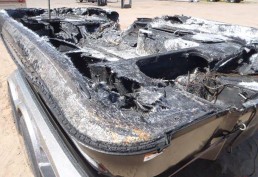Boat Insurance: What You Need to Know
SHARE THIS POST
Jim Kalkofen shares his conversation with boat insurance specialist Bob Luellen who explains what every boat owner needs to know to properly insure their boat.
Across the lakes and waters of North America, fishermen pay more attention to their electronics than they do their boat insurance; more attention to lure color than boat insurance; more attention to the next cast than boat insurance.
Surprise! Many boaters may not be properly insured. This includes anyone driving boats owned by others. This applies to most cabin owners and lake neighbors. Tournament anglers, guides and those who give boat rides/demos also need insurance policies designed especially for them.
A marine insurance specialist shared more insights. Bob Luellen, a 30-year veteran in this business, said, “It’s best to own a stand-alone policy created specifically for what an individual needs, not a band-aid added to another policy.”
He cited one specific group—tournament fishermen—as an example. He met tournament professional walleye anglers in 2008 when he fished a Professional Walleye Trail event as a co-angler. He said, “Every pro I talked with did not understand the type of insurance he needed.” Being licensed in 48 states and representing 20 national companies, he was writing boating policies that addressed specific needs.
He created an education process so boaters could understand insurance. He also informed them about his operation compared to companies that specialize in homeowners. “The boats on tour and those that guides use daily are high-value fishing rigs, and if insured like a truck with an actual cash value policy and a total-loss accident occurred, the owner would only receive the depreciated value of what the insurance company says it’s worth.”
Bob knows from experience that model doesn’t work. With boats being financed for 10 to 12 years, owners should consider the “stated-value” policy. Boats being financed can quickly become like a home with a lower value than the mortgage. “Owners could be out of the fishing business if their payout under a traditional actual cash value wouldn’t allow them to pay off the bank note,” he said.
“What the agreed value policy means is if your rig is insured for $65,000, you’ll get $65,000 if a total loss occurs,” he said. Another consideration deals with replacement-cost coverage on partial losses like lower units or rock/pier damage to gel coat. “Many companies have sliding scale or depreciated (reduced) replacement value with time,” he said.
Are you enjoying this post?
You can be among the first to get the latest info on where to go, what to use and how to use it!
He continued his insurance education. “Like fishing, attention to detail is critical to insurance,” he emphasized. For instance, with electronics, he advised boaters to list with serial numbers and take photos of units installed. If a unit were stolen, he has the information and so does the boat owner. “Take a full inventory of gear, kicker motor, batteries and fishing equipment, just in case you have to prove what was in or on the boat. Keep receipts and review everything when the 2-year policy is renewed,” he said.
As a general rule, he also advised taking photos or video of all tackle box/tray contents. Same with rods and reels.
From his perspective and actual situations, Bob said guides have commercial exposure, and most general property and casualty companies don’t insure commercial activities. Boaters should understand that some companies exclude coverage for Great Lakes boating. Some companies don’t cover boats while in Canada. Some companies limit the number of guide trips. Some companies don’t offer unlimited towing and/or emergency services on land or water. “This is something you don’t need until you need it,” he said. Some companies don’t cover property damage. Most companies don’t cover a person when driving another owner’s boat. “This is something every pro and guide must have—it’s called non-owned watercraft liability,” he said, “And, not a bad idea if this remotely applies to you or your family.
Liability insurance is the least expensive of any policy. Get enough coverage for any eventuality. “This is how it works,” Bob said, “Liability coverage allows the insurance company to settle claims out of court without any out-of-pocket personal assets/payments from the client.”
The difference between $300,000 and $500,000 liability insurance is only about $30 to $40 a year, and he felt half a million dollars would handle 90 percent of cases. “Going from $100,000 to $300,000 only adds about $15 per year,” he said. Asked to describe the need for liability insurance for weekend warriors to tournament anglers, Bob said, “It’s extremely critical.”
Bob can be reached at the worldwidemarineins.com website.
For more helpful tips from the pros who know, subscribe to MidWest Outdoors on our website.
MWO
SHARE THIS POST
You may also like...
Nothing found.
Did you enjoy this post?
You can be among the first to get the latest info on where to go, what to use and how to use it!
Jim Kalkofen
Jim Kalkofen grew up with a fishing rod in his hands. After years in the PR game for Mercury and Mepps, he directed the Professional Walleye Trail. He and partners Al and Ron Lindner now provide weekly walleye and ice-fishing education and entertainment in Target Walleye/Ice, a free subscription email (targetwalleye.com). For more info: jim@targetwalleye.com or 651-356-5676.
